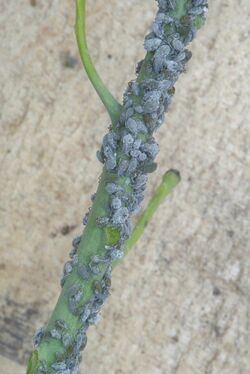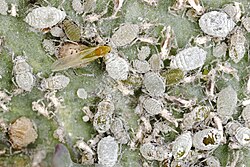Brevicoryne brassicae
Topic: Biology
 From HandWiki - Reading time: 2 min
From HandWiki - Reading time: 2 min
| Brevicoryne brassicae | |
|---|---|

| |
| Brevicoryne brassicae on curly kale | |
| Scientific classification | |
| Domain: | Eukaryota |
| Kingdom: | Animalia |
| Phylum: | Arthropoda |
| Class: | Insecta |
| Order: | Hemiptera |
| Suborder: | Sternorrhyncha |
| Family: | Aphididae |
| Genus: | Brevicoryne |
| Species: | B. brassicae
|
| Binomial name | |
| Brevicoryne brassicae | |
| Synonyms | |
|
Aphis brassicae | |
Brevicoryne brassicae, commonly known as the cabbage aphid or cabbage aphis, is a destructive aphid (plant louse) native to Europe that is now found in many other areas of the world.[1] The aphids feed on many varieties of produce, including cabbage, broccoli (especially), Brussels sprouts, cauliflower and many other members of the genus Brassica,[1] but do not feed on plants outside of the family Brassicaceae. The insects entirely avoid plants other than those of Brassicaceae; even though thousands may be eating broccoli near strawberries, the strawberries will be left untouched.[2]
Cabbage aphids, from the genus Brevicoryne of the family Aphididae, are grayish-green, but a waxy covering gives them a grayish-white[2] to powdery blue[3] appearance.
Predator defense mechanism
Cabbage aphids produce a myrosinase (beta-thioglucoside glucohydrolase) enzyme in head and thoracic muscles; the aphids also uptake glucosinolates, particularly sinigrin, from the plants on which they feed, storing the glucosinolates in their haemolymph. (Glucosinolates are natural defenses for plants in the order Brassicales against pests and herbivores.) The combination of the glucosinolates and the myrosinase enzyme produces a violent chemical reaction that releases the mustard oil chemical allyl isothiocyanate.[4] The defense mechanism has a dramatic negative effect on the survival of the larval ladybird predator Adalia bipunctata.[5] The chemical defence of the aphids has been likened to a "walking mustard oil bomb".[4][5]
The myrosinase from Brevicoryne brassicae appears to have evolved separately from myrosinases found in plants, possibly a case of convergent evolution.[6][7] Aphid myrosinase appears to have greater similarity to animal beta-O-glucosidases than to plant myrosinases.[7]
Pest control
Different varieties of cultivars have varying resistance to Brevicoryne brassicae.[8]
Diaeretiella rapae is a common wasp parasitoid of cabbage aphids.[2] Other controlling insects include ladybird beetles, syrphid fly larvae, and lacewing larvae.[1][2] Some insecticidal soaps may be effective in treating aphid infestations.[2]
References
- ↑ 1.0 1.1 1.2 Hawaii Department of Entomology information page
- ↑ 2.0 2.1 2.2 2.3 2.4 University of Minnesota extension
- ↑ Virginia Tech Department of Entomology
- ↑ 4.0 4.1 Imperial College London (2007, July 12). Aphids Make 'Chemical Weapons' To Fight Off Killer Ladybirds. ScienceDaily. Retrieved November 20, 2007, from https://www.sciencedaily.com/releases/2007/07/070711105844.htm
- ↑ 5.0 5.1 "The cabbage aphid: a walking mustard oil bomb". Proc. Biol. Sci. 274 (1623): 2271–7. 2007. doi:10.1098/rspb.2007.0237. PMID 17623639.
- ↑ "Purification and characterisation of a non-plant myrosinase from the cabbage aphid Brevicoryne brassicae (L.)". Insect Biochem. Mol. Biol. 31 (1): 1–5. 2001. doi:10.1016/S0965-1748(00)00157-0. PMID 11102829.
- ↑ 7.0 7.1 "Characterization and evolution of a myrosinase from the cabbage aphid Brevicoryne brassicae". Insect Biochem. Mol. Biol. 32 (3): 275–84. 2002. doi:10.1016/S0965-1748(01)00088-1. PMID 11804799.
- ↑ "Resistance to cabbage aphid (Brevicoryne brassicae) in six brassica accessions in New Zealand". New Zealand Journal of Crop and Horticultural Science 23: 25–29. 1995. doi:10.1080/01140671.1995.9513864.
External links
Wikidata ☰ Q2634837 entry
 |
 KSF
KSF
